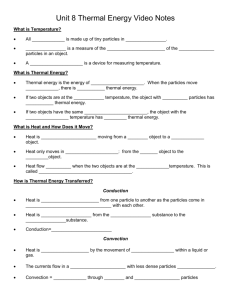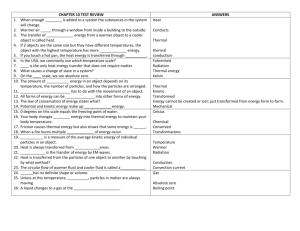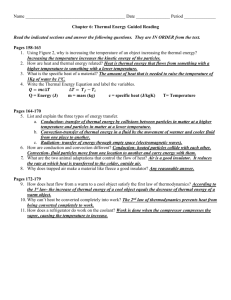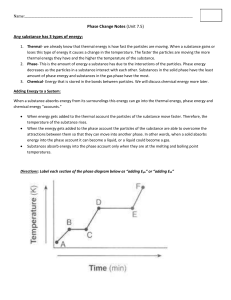Physical Science – Baker
advertisement
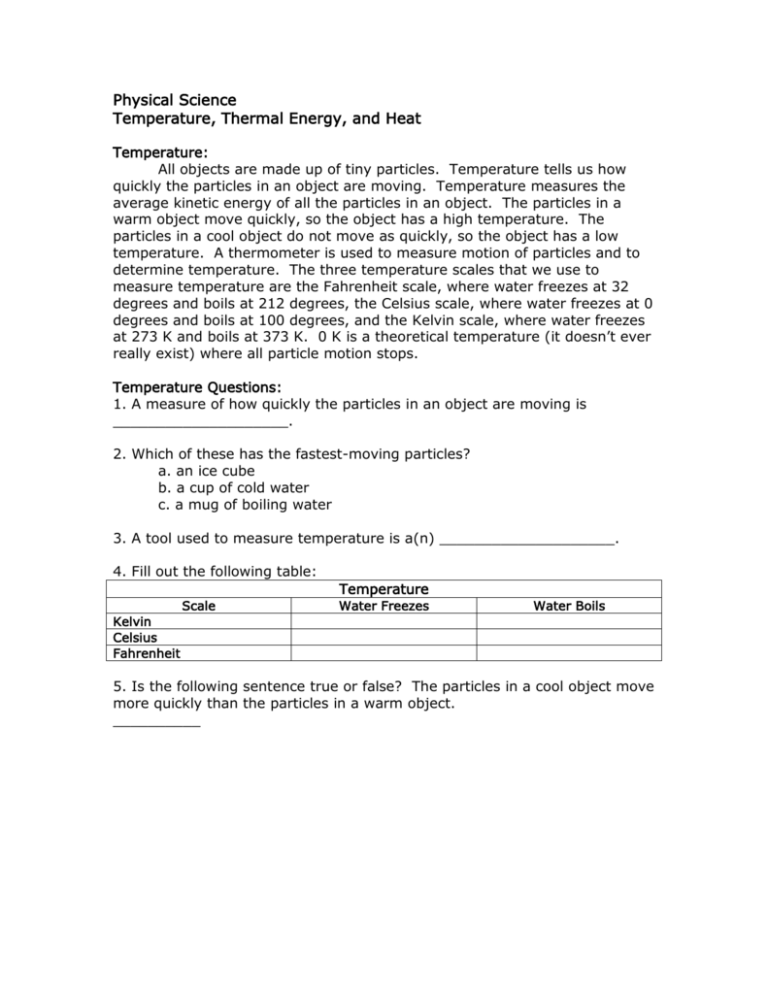
Physical Science Temperature, Thermal Energy, and Heat Temperature: All objects are made up of tiny particles. Temperature tells us how quickly the particles in an object are moving. Temperature measures the average kinetic energy of all the particles in an object. The particles in a warm object move quickly, so the object has a high temperature. The particles in a cool object do not move as quickly, so the object has a low temperature. A thermometer is used to measure motion of particles and to determine temperature. The three temperature scales that we use to measure temperature are the Fahrenheit scale, where water freezes at 32 degrees and boils at 212 degrees, the Celsius scale, where water freezes at 0 degrees and boils at 100 degrees, and the Kelvin scale, where water freezes at 273 K and boils at 373 K. 0 K is a theoretical temperature (it doesn’t ever really exist) where all particle motion stops. Temperature Questions: 1. A measure of how quickly the particles in an object are moving is ____________________. 2. Which of these has the fastest-moving particles? a. an ice cube b. a cup of cold water c. a mug of boiling water 3. A tool used to measure temperature is a(n) ____________________. 4. Fill out the following table: Temperature Scale Water Freezes Water Boils Kelvin Celsius Fahrenheit 5. Is the following sentence true or false? The particles in a cool object move more quickly than the particles in a warm object. __________ Thermal Energy and Heat Transfer: Thermal energy is the total energy of all the particles in an object. An object’s thermal energy depends on how fast its particles are moving. Thermal energy also depends on how many particles there are. That is why a liter of hot water has more thermal energy than a drop of water at the same temperature. Even though the Arctic Ocean is much colder than a pot of boiling water, the Arctic Ocean would have more thermal energy because it has many more particles. Cold objects can also have thermal energy. Even an ice cube has some thermal energy because its temperature is above absolute zero, or 0 K on the Kelvin scale. Moving thermal energy is called heat. Heat always moves from a warmer object to a cooler object. “Cold” is the absence of heat, and you feel it because heat flows from you to the cooler object. Cold can never move. Heat will move from the warmer object to the cooler object until they are both the same temperature. Thermal Energy and Heat Questions: 6. Circle the letters of two things that determine how much thermal energy an object has: a. How many particles it has b. Which temperature scale is used c. How fast its particles are moving 7. Thermal energy that moves from a warmer object to a cooler object is called ________________. 8. A warm cup of hot liquid is on a cool countertop. Draw a picture and label the direction that heat moves: 9. Read the words in the box. Use the words to fill in the blanks in the flowchart about heat: Cooler object Thermal Energy Warmer object Heat moves from a (A.) ____________________ to a (B.)____________________ until both are at the same temperature

